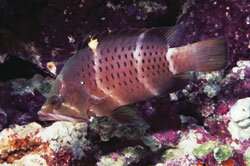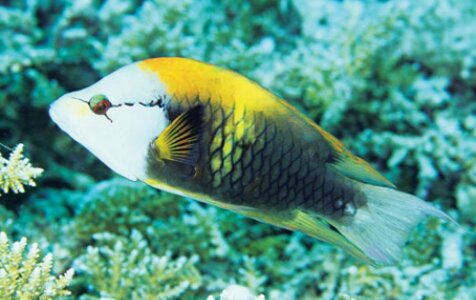Slingjaw Wrasse
From Microcosm Aquarium Explorer
Overview
Epibulus insidiator makes a very interesting aquarium resident. It is an efficient predator that will snap up glass shrimp and feeder fish with incredible speed.
One potential problem with keeping these fish with other species is that they are so quick that they may prevent more sluggish predators from getting enough to eat.
Of course, feeder goldfish should not be a staple of the diet of this fish or any marine species. If you feed ghost shrimp, you should gut-load them with a nutritious frozen or flake food.

The adult Slingjaw Wrasse needs a large aquarium (135 gallons or larger) and should be provided with plenty of large refuge sites to hide in if threatened. In nature it this a shy species that is typically difficult to approach. They are also reclusive and nervous when first introduced to the aquarium, although this will change once they learn to recognize the aquarist as a provider rather than a potential threat. When this occurs the fish will not only rise to the surface of the tank when its keeper approaches, it will also take food from the aquarist's fingers.
Juveniles will acclimate quickly to captive life if they are kept in a tank that does not contain aggressive fishes and has plenty of hiding places. They will spend most of their time slinking from crevice to crevice, but they will also swim in open areas if the tank is in a low-traffic area. Smaller individuals do well in reef aquariums, but as they mature, they will pose a threat to shrimps and smaller fishes. Be aware that these fish are capable of jumping out of open aquariums. This is most likely to occur if they are harassed by tankmates.
Juvenile E. insidiator closely resemble the Whitebanded Possum Wrasse, Wetmorella fasciata. They are greenish brown with white lines on the head and body and a black spot on both the dorsal and anal fins. They are also very secretive, spending most of their time among coral branches or in crevices. (See Notes, below.)
Family: Labridae
Other common name(s):
Native range:
- Indo-Pacific
- Red Sea
- Hawaiian Islands
- Tuamoto Islands
- New Caledonia
- Southern Japan
Habitat: Usually found on reef faces and fore-reef slopes and around lagoon fringing and patch reefs. It is most often found in areas with rich stony coral growth. It occurs at depths ranging from 1 to 42 m (3 to 137 ft.) and attains a maximum length of 35 cm (14 in.).
Maximum length: 25 cm (10 in)
Minimum aquarium size: 500 L (132 gal)
Water: Marine 24 °C (75 °F) - 28 °C (82 °F)
General swimming level: All levels.
Feeding
Carnivore. Although they can be switched to frozen preparations or fresh or frozen seafood, including fresh or frozen table shrimp and strips of squid or clam, they prefer live foods such as feeder fish, shrimps, and even live insects (e.g., crickets) that are floating on the water's surface, as well as black worms and earthworms.
Aquarium Compatibility
Epibulus insidiator is a solitary species and only one individual should be kept per aquarium. Although these individuals are not usually aggressive toward other fish species in the aquarium, I have seen them chase heterospecifics in the wild.
For example, I observed an adult male E. insidiator persistently chase a snapper that was hanging in the water. Unfortunately, bright yellow females often turn brown in aquarium confines; this may be due to a lack of social interaction with conspecifics
Breeding/Propagation
The Slingjaw Wrasse displays striking sexual dichromatism. Subadults and some females are brown, while other females are bright yellow. Males are dark brown, with green edges on the scales, a yellow bar on the side, and a gray head with a black streak behind the eye. Brown individuals are the most commonly encountered form, followed by the terminal phase males. The yellow females are least common. Epibulus insidiator is a protogynous hermaphrodite (i.e., it changes from female to male), and transforming individuals displaying a combination of female and male characteristics are occasionally encountered. Terminal phase males are not only different in color from initial phase individuals, they are also considerably larger.
Notes
Brown subadult and small adult Slingjaw Wrasses (between 5 and 10 cm [2 to 4 in.]) have been observed to disperse from one reef to another using a very unusual behavior that has been dubbed ‚"drift emigration."
When the tide begins to go out, the Slingjaws swim to the surface, either singly or in groups of up to four individuals, and join floating plant debris. The plant material can include tree leaves, ferns, and seagrass. The Slingjaw Wrasse curls its tail toward its body, folds its fins up, and begins to float with the debris. Slingjaw Wrasses have even been observed to adopt the coloration of the plant material. For example, if the leaves are yellow, the fish will change to a yellowish hue overall.
It has been suggested that this behavior may not only help these fish safely move from one area to another, but may also enable them to prey on small, elusive fishes that often associate with floating debris.
See the protrusible mouth parts of this species in action in this YouTube video: [1]









